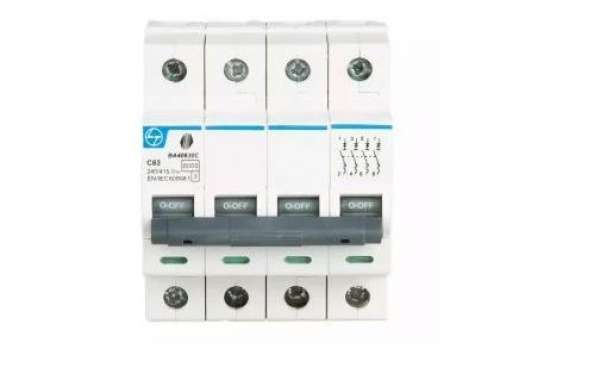In the field of electrical circuit protection, Moulded Case Circuit Breakers (MCCBs) stand as stalwart guardians, capable of handling higher currents and providing enhanced protection in diverse applications. Understanding the nuances of MCCBs, including their pricing and distinctions from Miniature Circuit Breakers (MCBs), is crucial for making informed decisions in electrical installations. In this comprehensive guide, we delve into the intricacies of moulded case circuit breakers, explore their pricing dynamics, and elucidate the key differences between MCCBs and MCBs.
Unravelling Moulded Case Circuit Breakers
Moulded Case Circuit Breakers (MCCBs) are robust circuit protection devices designed to safeguard electrical circuits against overloads, short circuits, and other electrical faults. Unlike Miniature Circuit Breakers (MCBs), which are typically used for low-voltage applications and moderate currents, MCCBs are capable of handling higher currents ranging from tens to thousands of amperes.
MCCBs feature a moulded case housing that encapsulates the internal components, providing insulation and protection against environmental factors such as dust, moisture, and mechanical stress. These circuit breakers are commonly used in industrial, commercial, and high-power distribution applications, offering reliability, durability, and customizable trip characteristics to suit diverse requirements.
Understanding Moulded Case Circuit Breaker Price
The pricing of moulded case circuit breakers (MCCBs) varies based on several factors, including:
1. Current Rating:
MCCBs are available in a wide range of current ratings, from tens to thousands of amperes. Higher current ratings typically command higher prices due to the increased materials and engineering required to handle larger electrical loads.
2. Breaking Capacity:
The breaking capacity, or interrupting rating, of an MCCB denotes its ability to safely interrupt fault currents without sustaining damage. MCCBs with higher breaking capacities are designed to handle more severe fault conditions and may incur higher costs as a result.
3. Brand Reputation:
Established brands with a reputation for quality and reliability often price their MCCBs at a premium. While reputable brands may offer superior performance and after-sales support, they may come with a higher upfront cost.
4. Features and Accessories:
Advanced features such as adjustable trip settings, ground fault protection, and communication capabilities can influence the price of MCCBs. Additionally, accessories such as shunt trips, undervoltage releases, and auxiliary contacts may incur additional costs but enhance the functionality and versatility of the MCCB.
Difference Between MCB and MCCB
While both MCBs and MCCBs serve the fundamental purpose of circuit protection, they differ significantly in terms of their applications, capabilities, and operating characteristics. Some of the key differences between MCBs and MCCBs include:
1. Current Handling Capacity:
MCBs are typically designed for low-voltage applications and moderate currents, typically up to 125 amperes. In contrast, MCCBs are capable of handling higher currents, ranging from tens to thousands of amperes, making them suitable for industrial and high-power distribution systems.
2. Trip Characteristics:
MCBs are often designed with fixed trip characteristics, providing standard protection against overloads and short circuits. MCCBs, on the other hand, offer customizable trip settings, allowing users to adjust parameters such as the trip curve, delay, and sensitivity to suit specific application requirements.
3. Construction and Size:
MCBs are compact devices designed for installation in modular enclosures or consumer units, making them well-suited for residential and commercial settings. MCCBs are typically larger and more robust, featuring a moulded case construction that provides enhanced protection and insulation for industrial and high-power applications.
4. Cost:
While MCBs are generally more affordable due to their smaller size and simpler construction, MCCBs may come at a higher price point due to their larger capacity, customizable features, and industrial-grade build quality.
Advanced Features and Customization Options
One of the distinguishing features of MCCBs is their ability to offer advanced functionalities and customization options, catering to the specific needs of diverse applications:
1. Adjustable Trip Settings:
MCCBs often come with adjustable trip settings, allowing users to fine-tune parameters such as the trip curve, current sensitivity, and time delay. This customization capability enables precise coordination with downstream devices and enhances system reliability.
2. Communication and Monitoring:
Many MCCBs are equipped with communication modules and monitoring features, enabling remote monitoring, diagnostics, and predictive maintenance. These capabilities facilitate real-time data analysis, proactive fault detection, and timely interventions to prevent downtime and optimize asset performance.
3. Selective Coordination:
MCCBs offer selective coordination capabilities, ensuring that only the MCCB nearest to the fault trips while allowing downstream devices to remain operational. This selective coordination enhances system reliability and minimizes disruptions, particularly in complex electrical networks with multiple MCCBs.
4. Ground Fault Protection:
Some MCCBs are equipped with ground fault protection, detecting and interrupting ground faults to prevent electrical shocks and equipment damage. Ground fault protection is essential in applications where personnel safety and equipment integrity are paramount, such as in healthcare facilities and manufacturing plants.
Installation Considerations and Lifecycle Management
In addition to considering the features and pricing of MCCBs, it's essential to address installation considerations and lifecycle management factors:
1. Installation Requirements:
Proper installation by qualified electricians is crucial to ensure the optimal performance and safety of MCCBs. Attention should be paid to factors such as wiring, mounting, and enclosure requirements to comply with relevant standards and regulations.
2. Maintenance and Testing:
Regular maintenance and testing of MCCBs are essential to verify their proper operation and adherence to trip characteristics. Routine inspections, thermal imaging, and functional testing help identify potential issues and ensure MCCBs are ready to respond to faults effectively.
3. Lifecycle Cost Analysis:
While the upfront cost of MCCBs may be higher compared to MCBs, conducting a lifecycle cost analysis can reveal the total cost of ownership over the MCCB's lifespan. Factors such as energy efficiency, reliability, maintenance costs, and potential downtime should be considered to assess the long-term value proposition of MCCBs.
Conclusion
In conclusion, understanding the distinctions between Moulded Case Circuit Breakers (MCCBs) and Miniature Circuit Breakers (MCBs) is essential for selecting the appropriate circuit protection solution for diverse applications. While MCBs excel in low-voltage settings and moderate current applications, MCCBs offer robust protection and customizable features for industrial, commercial, and high-power distribution systems.




